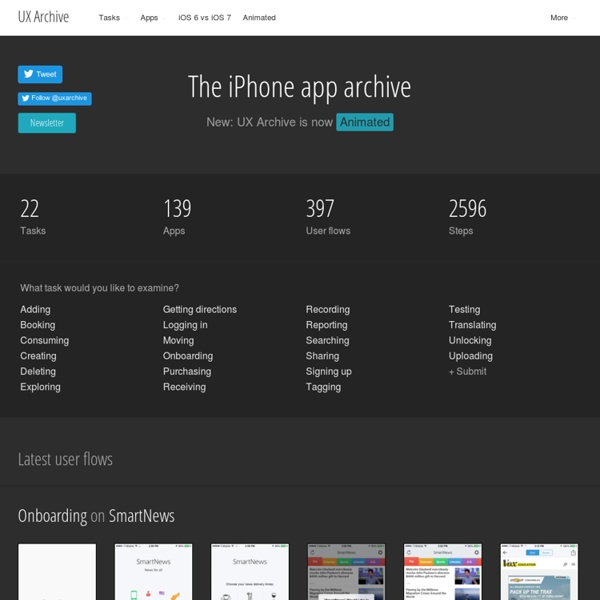



Toolglass and Magic Lenses: The See-Through Interface Bier, E. A., Stone, M., Pier, K., Buxton, W. & DeRose. T. (1993). Toolglass and magic lenses: the see-through O’Reilly TopicsGo! Welcome back. Please sign in. Welcome back. Paper Fold Effect in App Design - UI A round up of all cool paper fold design from dribbble. Paperfolding technique is one of the cool UI effects used in Mobile App because it works very well and quite realistic with touch gesture. Here, a few are pure concept and a few are actually a real implementations. About Kevin
Full Spectrum: 10 Books on Sensemaking for the TED 2012 Bookstore This week, I’m at TED , where I had the honor of curating a selection of books for the TED Bookstore around this year’s theme, . Here are my picks, along with the original text that appears on the little cards in the bookstore, and my blurb about the selection: I believe creativity is combinatorial — it’s our ability to take existing pieces of knowledge, information, insight, and ideas that we’ve gathered over the course of our lives, and recombine them into new ideas. Curation – the purposeful filtration of information – is what fills our mental pool of resources with the most meaningful building blocks of creativity possible. In a way, it’s a sensemaking mechanism for the world, allowing us to see not only why different pieces matter but also how they relate to one another and might fit together.
TimeViz Browser Imrich, P.; Mueller, K.; Imre, D.; Zelenyuk, D. & Zhu, W.: Interactive Poster: 3D ThemeRiver. Poster Compendium of IEEE Symposium on Information Visualization (InfoVis), IEEE Computer Society, 2003. Imrich, P.; Mueller, K.; Imre, D.; Zelenyuk, D. & Zhu, W. (2003), © 2003 IEEE. Used with permission. Image courtesy of Ben Fry, MIT Media Laboratory, Aesthetics + Computation Group, © 1999-2005. Anemone by Fry, B. (2000) is a technique related to the visualization of structured information.
Creative UI Design Examples for Great UX UX (User Experience) is all those elements and factors related to the user's interaction with a particular environment or device which generate a positive or negative perception of the product, brand or device. UX is subjective and focused on use. The standard definition of UX is "a person's perceptions and responses that result from the use or anticipated use of a product, system or service".
Content Curation Primer Photo by Stuck in Customs What is Content Curation? Content curation is the process of sorting through the vast amounts of content on the web and presenting it in a meaningful and organized way around a specific theme. The work involves sifting, sorting, arranging, and publishing information. A content curator cherry picks the best content that is important and relevant to share with their community. It isn’t unlike what a museum curator does to produce an exhibition: They identify the theme, they provide the context, they decide which paintings to hang on the wall, how they should be annotated, and how they should be displayed for the public.
abduzeedo.com Free Mobile Website Creator Building a Kick-Ass Social Media Dashboard If you are tasked with building a social media dashboard to track your efforts, look no further than this post. I have built many dashboards over the years and as a personal resolution to making my job easier, I decided to cut to the chase and get to the metrics that matter most. That means cutting out the everyday metrics that litter and cloud up the social media manager’s real success story. Now I am not saying that tracking followers, fans, sentiment, etc. is not important, but those are the vanity metrics that tend to give social media a bad name. These type of metrics are great indicators but they don’t really tie back to your business bottom line: driving revenue.
Donations Building a fact-based world view Gapminder is a non-profit foundation based in Stockholm. Our goal is to replace devastating myths with a fact-based worldview. Network Visualization Immersion by the MIT Media Lab is a view into your inbox that shows who you interact with via email over the years. Immersion is an invitation to dive into the history of your email life in a platform that offers you the safety of knowing that you can always delete your data.Just like a cubist painting, Immersion presents users with a number of different perspectives of their email data. It provides a tool for self-reflection at a time where the zeitgeist is one of self-promotion. It provides an artistic representation that exists only in the presence of the visitor. It helps explore privacy by showing users data that they have already shared with others.
Assessing Your Team's UX Skills By Jared M. Spool Originally published: Dec 10, 2007 "I didn't realize it required so many different skills," the newly-appointed user experience (UX) team manager told us.
An archive of the most interesting user flows for inspiration to design the best user experiences / UI by angelahoatwork Mar 12